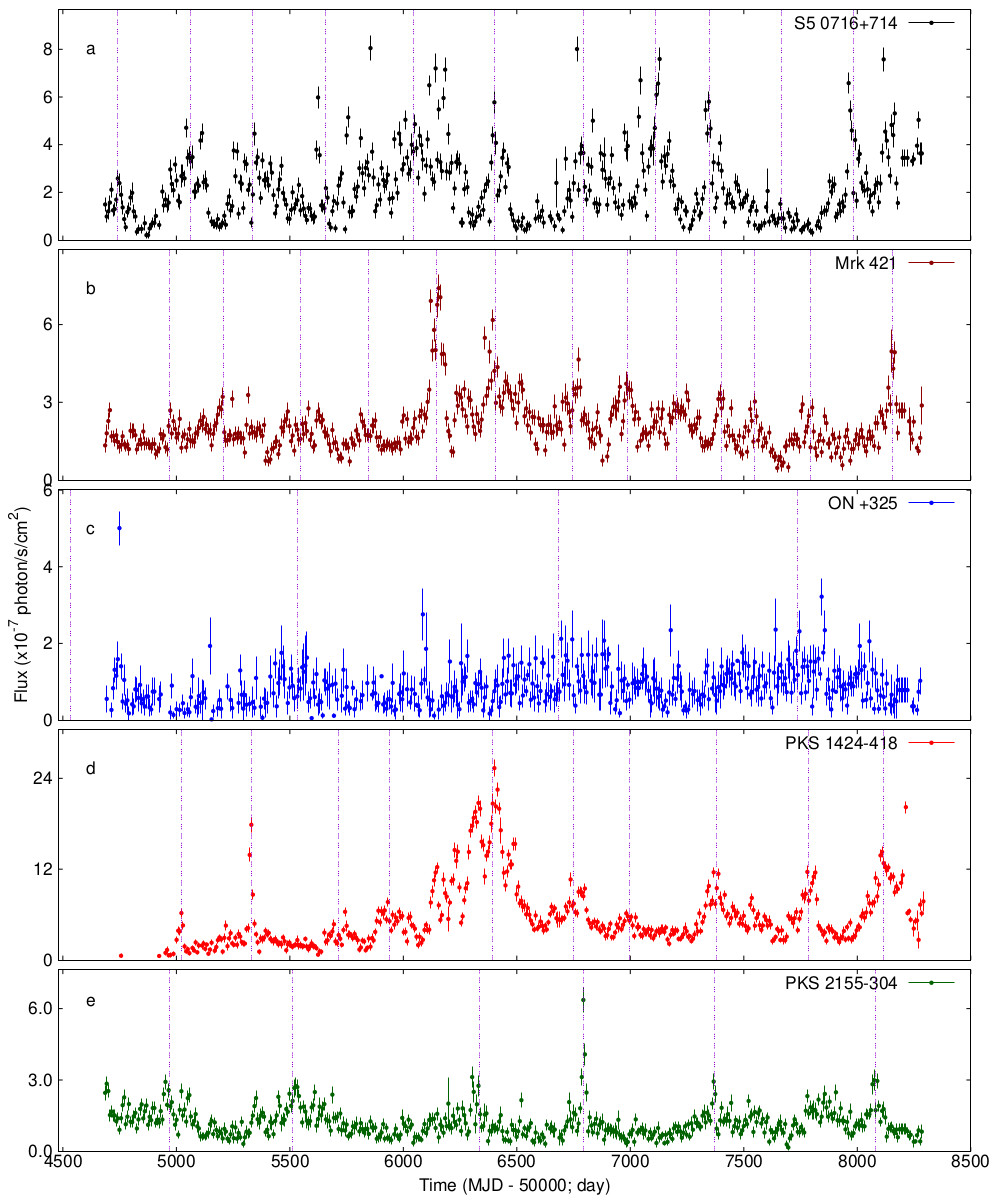Astronomy Object of the Month: 2020, March
< previous Archive next >
The Nature of γ-ray Variability in Blazars
Blazars shine predominatly in high energy emission, e. g. X-ray and gamma-ray wave bands. It is widely believed that
the high energy emission is produced via synchrotron and inverse-Compton processes at the relativistic shock waves
which propagate along the blazar jets or magnetic reconnection processes in case of highly magnetized jets. However,
in spite of the collaborative efforts of several modern space and earth bound telescopes, the details of the mechanisms
and the exact location of the production of the high energy emission, in reference to the central engine, remain elusive.
To characterize the statistical properties of gamma-ray variability in
blazars, a systematic study of a sample of 20
powerful blazars was carried out applying various analysis tools such as flux distribution, symmetry analysis, and time
series analysis on the decade-long Fermi/LAT observations.
 Illustration: The Fermi/LAT blazar light curves from
2008-2018 showing signatures of quasi-periodic oscillations. Credit: G. Bhatta & N. Dhital.
Illustration: The Fermi/LAT blazar light curves from
2008-2018 showing signatures of quasi-periodic oscillations. Credit: G. Bhatta & N. Dhital.
The results show that gamma-ray emission from blazars is highly pronounced and variable over diverse temporal frequencies. In the study a steep positive correlation between fractional variability and the gamma-ray spectral index was observed suggesting that the variability is highly sensitive to its spectral slope. Moreover, the gamma-ray flux distribution could be closely approximated as lognormal probability density function, in contrast to the normal probability density function. Similarly, the statistical symmetry analysis including a comparison between the distribution of flux rising and decay rates in the gamma-ray light curves showed that both the distribution are very similar; counter-intuitively this means that the intrinsic difference in the timescales on which the acceleration and the cooling processes operate are washed out over the spatial extension of the radio jets.
Furthermore, most of the sources appear to exhibit a linear RMS-flux relation revealing that blazars tend to be more variable during their higher flux states. To constrain the statistical nature of such variability over a wide range of temporal frequencies, extensive Monte Carlo simulations were employed to estimate the power spectral density which best represent the blazar gamma-ray periodogram. The study resulted that the power spectral density of the light curves are consistent with a single power-law, P(ν) ~ 1/ν, with spectral indexes centered around unity.
This might lead to the conclusion that the nature of variability as as characterized by flicker-noise might be driven by long-memory processes in the sense that the memories of the disk processes are carried along by the jet emission. Additionally, periodic behavior of the blazar systems was studied using time series analysis, and some of the sources in the sample, including S5 0716+714, Mrk 421, ON +325, PKS 1424-418 and PKS 2155-304, in fact revealed spectral features that indicated presence of year timescales QPOs that are highly significant over the possible artifacts usually found in blazar light curves.
Original publication: G. Bhatta, N. Dhital, The Nature of γ-ray Variability in Blazars, The Astrophysical Journal, 2020.
The research was conducted at the High Energy Astrophysics Department of the Jagiellonian University Astronomical Observatory. The work was supported by the Polish National Science Centre through the grant UMO-2017/26/D/ST9/01178.
|
Gopal Bhatta Astronomical Observatory Jagiellonian University G.Bhatta [at] oa.uj.edu.pl |


